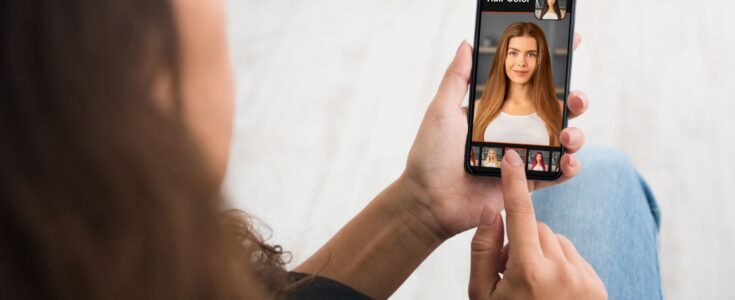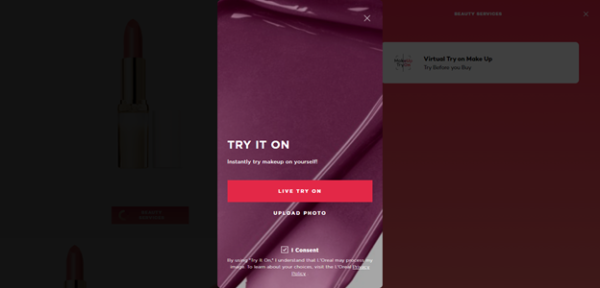

The cosmetics and beauty industry has a history of bouncing back quickly after economic downturns, and this trend will continue as we return to a new normal.
The impact of COVID-19, the subsequent lockdown and social distancing norms on the beauty industry, and colour cosmetics, in particular, has been substantial. But this doesn’t mean people aren’t still curious about the products and services.
The cosmetics and beauty industries have historically shown resilience during economic downturns, and they will be among the first to recover as we return to a new normal. One thing, however, is certain as we consider the industry’s potential in the future: consumer preferences have changed, and they are unlikely to go back to the way they were.
So, in this post, we’ll explore how technology is leveraged to get ahead in the game.
The term “augmented reality” (AR) refers to an immersive environment of a real-world environment in which objects in the real world are amplified by computer-generated perceptual information. This information can target one or more of the senses, such as sight, sound, touch, smell, or taste. Augmented reality (AR) is a structure that combines the real and virtual worlds, allows for real-time interaction, and precisely registers virtual and real objects in 3D space.
It is anticipated that augmented reality (AR) will significantly alter the way consumers conduct their product searches. Even though augmented reality is still in its infancy, it is already influencing the beauty industry in three significant ways. Shopping apps are entertaining customers by letting them see how makeup can change their appearance without actually visiting a store, educating them about the products available, and allowing them to personalise their online and offline shopping experiences.
The decreasing amount of hassle associated with making a purchase is a contributing factor to the technology’s growing popularity. The common problem of making a purchase without knowing if it was the right one until after the fact can be alleviated with the help of augmented reality apps.
The home furnishings market also struggles with this issue. Nobody wants to buy something online, have it shipped to their house, and then have to assemble it only to discover that it won’t fit in their apartment.
For this reason, major furniture retailers like Ikea and Wayfair have developed their own augmented reality apps. This is similar to the rationale behind the advent of “try before you buy” services by companies like Amazon. Customers can save time by better visualising products through AR before making a purchase.
The ability to virtually try on products with an app and then make a purchase within the same app is also contributing to the technology’s rise in popularity.
Learn how we helped beauty brand to deliver Omni-channel experience across web, app, and brick-and-mortar stores impacting business revenue online and offline.
Download the Case Study to know the success story of a Beauty Brand.
1. Virtual Try-On
Virtual makeup application is one of the most well-known applications of augmented reality in the beauty business. Lipstick, eyeshadow, and other cosmetics can be tried on in real-time, eliminating the need to visit a store.
Two types of augmented reality experiences, “Slidescreen” and “Interactive,” were developed by brands to meet this need. Instagram users could utilise the “Slidescreen” feature to see how different lipstick colours might look on their lips by dividing the screen in two.
Users in the “Interactive” mode were shown a virtual mirror with five different lipsticks surrounding them. For example, if you clicked on the “peach flirt” lipstick, some cute animations would start playing in the background.

2. Virtual Makeup Tutorial
The virtual mirror is meant to facilitate quicker colour testing without requiring consumers to upload images by presenting colour on the customers’ faces. It’s also anticipated that this will boost brand marketing sales.
In addition to all of the aforementioned benefits, the virtual mirror also lets customers try on several shades of makeup in an instant. Customers can test out different eye makeup textures, such as glitter, sparkle, and shine, by tapping a colour palette on the Beauty Mirror screen.
They are able to see the items from any angle by simply tilting their head, which should aid consumers in making a purchase decision.
Popular cosmetics retailer Sephora, for instance, recently announced a partnership with Augmented Reality (AR) mirror creator ModiFace. The mirror has the ability to show the user the effects of their makeup in a photorealistic manner as they apply it. This new development unquestionably modifies the cosmetics-buying habits of modern-day ladies.

3. Virtual Beauty Filters
The beauty production process is becoming increasingly important to consumers, but that doesn’t mean they’ll take the time to read a company’s website to learn about it, especially if the information is presented in a dull way. To fill this void, the cosmetics industry is experimenting with novel methods of client education and brand engagement.
A fantastic example of this is Aveeno. Aveeno teamed up with Poplar Studio earlier this year to create an augmented reality filter that would demonstrate to clients how the Skin Relief line of products was made.
Poplar Studio fused a global effect with an augmented reality face filter to create a one-of-a-kind experience for the brand’s oat-based skincare products, which was then made available on social media platforms including Instagram and Facebook. Users initiated the effect by holding up an animated Aveeno bottle.
At that time, the manufacturing process was explained via voiceover while entertaining 3D elements and animations played in the background. The story would end with a suggestion to utilise the front-facing camera and apply the Aveeno face filter, which would make the user’s skin look radiant and add an oat crown to their head.

4. Augmented Reality Campaigns in Beauty Industry
Taking the plunge to dye your hair a new colour is a risky one, especially if you want to try something audacious but aren’t sure if it would look good on you.
L’Oréal devised an augmented reality campaign to help hesitant clients visualise how they would look with new hair colour before making a purchase.
The TikTok effect, developed by Poplar Studio, let users immediately alter their hair colour to stunning rose gold and capture a video of the “transformation,” which they could then transmit to their friends.

5. Virtual Store
A virtual store facilitates a digital tour of your favourite beauty products, where you may even purchase items.
Lizzie Para (BLP) Beauty, an Indonesian cosmetics firm, took the initiative to create something novel to publicise the opening of a new location, and thus the concept came to fruition.
BLP Beauty’s virtual store was built by the company in conjunction with Assemblr. BLP Beauty has introduced a novel way to shop for cosmetics by creating a virtual sample bar using augmented reality.
The online shop is an identical replica of the physical one in BLP Beauty Space Yogyakarta. With only a few touches, customers can take a guided tour and receive a coupon good toward the purchase of their preferred cosmetics. In keeping with its motto, “Beauty is for Everyone,” BLP Beauty makes it easier for its consumers to take a look around and make handy purchases.
The cosmetics market is one sector actively participating in the “new retail” phenomenon. And augmented reality is the technology of choice to power this.
Despite several difficulties, virtual cosmetics apps that use augmented reality have the potential to offer considerable benefits. Your company should definitely start providing augmented reality beauty technology to customers, especially because an estimated 700 million people have used a virtual try-on experience.
When it comes to skincare, in particular, there is a lot of brand loyalty in the beauty industry, and providing consumers with fun augmented reality applications can be a game changer when it comes to keeping customers coming back. Plus, they want to raise their market share steadily.
It’s crucial that products look and feel great on a wide range of skin tones and colours. Since there are an endless number of variations, the photos used to make the overlays must include examples of each, as well as accurately portray the appropriate product texture.
Collating all those visuals is a significant task but absolutely important if you plan to deliver a holistic virtual try-on experience with AR.
Connect with us at Apexon to know more.